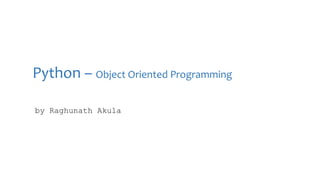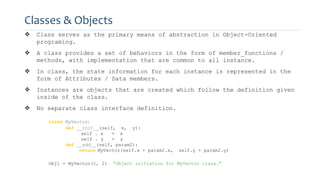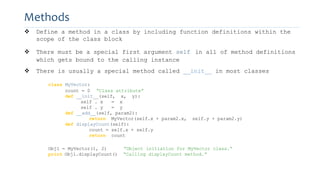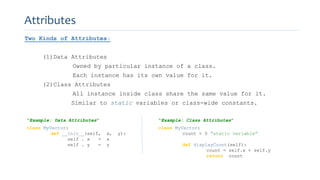Python – Object Oriented Programming
- 1. Python – Object Oriented Programming by Raghunath Akula
- 2. Classes & Objects Class serves as the primary means of abstraction in Object-Oriented programing. A class provides a set of behaviors in the form of member_functions / methods, with implementation that are common to all instance. In class, the state information for each instance is represented in the form of Attributes / Data members. Instances are objects that are created which follow the definition given inside of the class. No separate class interface definition. class MyVector: def __init__(self, x, y): self . x = x self . y = y def __add__(self, param2): return MyVector(self.x + param2.x, self.y + param2.y) Obj1 = MyVector(1, 2) “Object initiation for MyVector class.”
- 3. Access Specifiers Python provides a number of access modifiers to help you set the level of access for attributes and methods. Private - 2 leading under-scores in its name, but none at the end. Can’t be accessed outside of class Built-in – Methods or attributes having 2 underscores at the beginning and the end. Doesn’t support ‘protected’. Subclasses would be unable to access these private data either. Garbage Collector Python has automatic garbage collection. Will automatically detect when all of the references to a piece of memory have gone out of scope. Automatically frees that memory. There’s also no Destructor method for classes
- 4. Methods Define a method in a class by including function definitions within the scope of the class block There must be a special first argument self in all of method definitions which gets bound to the calling instance There is usually a special method called __init__ in most classes class MyVector: count = 0 “Class attribute” def __init__(self, x, y): self . x = x self . y = y def __add__(self, param2): return MyVector(self.x + param2.x, self.y + param2.y) def displayCount(self): count = self.x + self.y return count Obj1 = MyVector(1, 2) “Object initiation for MyVector class.” print Obj1.displayCount() “Calling displayCount method.”
- 5. Constructor ( __init__ ) Serves as a constructor for a class. The arguments passed to the class are given to its __init__() method def __init__(self, x, y): self . x = x self . y = y self The first argument of every method is a reference to the current instance of the class Parameter object self refers to current object being created, similar to keyword this in Java Although self explicitly mentioned when defining the method, not mandatory included while calling the method. Self parameter is passed automatically by python.
- 6. Attributes Two Kinds of Attributes: (1)Data Attributes Owned by particular instance of a class. Each instance has its own value for it. (2)Class Attributes All instance inside class share the same value for it. Similar to static variables or class-wide constants. “Example: Data Attributes” class MyVector: def __init__(self, x, y): self . x = x self . y = y “Example: Class Attributes” class MyVector: count = 0 “static variable” def displayCount(self): count = self.x + self.y return count
- 7. Inheritance A class can extend the definition of another class Allows to use methods and attributes already defined in the previous classes. To define a subclass, put the name of the superclass in parentheses “(…)”. Python has no ‘extends’ keyword like Java. Python supports multiple inheritance. “Extending MyVector class” class SubVector (MyVector): def __init__(self, sub_x, sub_y): self . x = sub_x self . y = sub_y def displayCount(self): count = self.x + self.y return count
- 8. Method Overriding Overriding is a very important part of OOP. It has the ability of a class to change the implementation of a method provided by one of its ancestors. Python inheritance works through implicit delegation – when the object cannot satisfy a request, it forward request to its ancestors. “Parent Class” class MyVector: def __init__(self, x, y): self . x = x self . y = y def displayCount(self): return self.x + self.y “Child Class” class SubVector (MyVector): def displayCount(self): “Overriding dispalyCount method” return self.x + 10
- 9. Thank you!!








